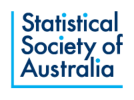JOANNA WANG SHOWS USE OF STATISTICS FOR CRIMINAL JUSTICE (AUGUST 2020)
University of Technology Sydney senior lecturer Joanna Wang describes statistical evaluation of a prison alternative.
About 50 society members logged into Zoom on 27th August 2020 to hear about Joanna Wang's work with the New South Wales Bureau of Crime Statistics and Research. This bureau has lots of publicly available data on crime and prison populations. An example of its objectives is to identify factors that affect the frequency and distribution of crime.
Most of Joanna's presentation was on a case study concerning evaluation of a prison alternative known as an intensive correction order. If a judge gives you an intensive correction order then, rather than sending you to Long Bay, Goulburn or Grafton Gaol, then you have to do at least 32 hours of community service work a month, participate in programmes and submit yourself to regular drug and alcohol testing. New South Wales gaols are filling up at an unprecedented rate so there is a great deal of interest in this non-prison alternative. The research aim that Joanna presented to us was:
"to examine the risk of re-offending on those who receive an intensive correction order, relative to those who received a short (less than 2 years) prison sentence".
Randomised clinical trials to are not an easy, or ethical, option in this case and so propensity score and instrumental variable methods were used instead. One analysis of this kind led to a 31% reduction in the odds ratio of re-offending for intensive correction order offenders, with a reasonable degree of statistical significance.
As advertised by Joanna towards the end of her talk, the details of the case study are in a 2017 paper by J.J.J. Wang and S. Poynton in the "Crime and Justice Bulletin" (No. 207).
Matt Wand
University of Technology Sydney
